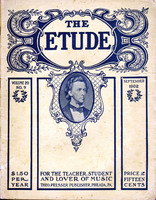Prof. E. W. Scripture contributes an article entitled “How the Voice Looks” to a recent number of the Century. Professor Scripture is director of the Psychological Laboratory of Yale University, and if his views are accepted there promises to be a revolution in vocal teaching. The illustrations tell some curious stories. Here is one statement from the experimenter:
Not long ago I stated these facts to a well-known clef club, and supported them by the curves of German vowels sung into and traced from a phonograph by Professor Hermann, of Königsberg; by pictures of spoken English vowels obtained in a different way by Professors Nichols and Merritt, of Cornell; by analyses of Finnish vowels by Dr. Pipping, of Helsingfors; by direct observations of the vocal cords made by Dr. Musehold according to a new method, and by the results of other investigations. The statements were received with a dismay mitigated only by incredulity. One member even remarked that such views “would, if true, knock all our theories of vocal instruction into a cocked hat.” There was, in fact, a natural reluctance to giving up the Helmholtz overtone theory of vocal resonance. The abandonment of the incorrect theory of vocal action will probably require modifications in the present methods of vocal instruction, but that is a matter for the musicians to decide. I merely suggest that if the mouth-resonance cannot alter the sound from the cords except by mixture of new tones with it, it is hopeless to attempt to correct faulty cord-action by adjustment of the mouth; the cords must be trained to emit such forms of explosions as will produce the best effects on the ear.



